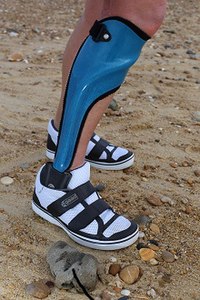
Photo from wikipedia
Abstract In this paper, the problem of trajectory tracking, for an Actuated-Ankle–Foot-Orthosis(AAFO) to assist the gait of paretic patients, is addressed. The control strategy is based on the system’s flatness… Click to show full abstract
Abstract In this paper, the problem of trajectory tracking, for an Actuated-Ankle–Foot-Orthosis(AAFO) to assist the gait of paretic patients, is addressed. The control strategy is based on the system’s flatness property, which allows the development of an Active Disturbance Rejection Control (ADRC). For this purpose, an Extended State Observer (ESO) is designed to estimate on-line the unknown disturbances and canceled by injecting the output of ESO into the feedback loop. A stability analysis of the estimation error dynamics is carried out in the Input-to State Stability (ISS) framework, stating the observer’s robustness. On the other hand, the feedback design is based on the existence of a Control Lyapunov Function (CLF) and the Sontag’s formula. The stability analysis discloses that the tracking trajectory controller is ISS, i.e. robustly stable. Finally, the effectiveness of the ADRC strategy is validated by performing real-time tests with a healthy subject walking on a treadmill at self-selected speed. The experimental results validate the theoretical analysis.
Journal Title: Control Engineering Practice
Year Published: 2018
Link to full text (if available)
Share on Social Media: Sign Up to like & get
recommendations!